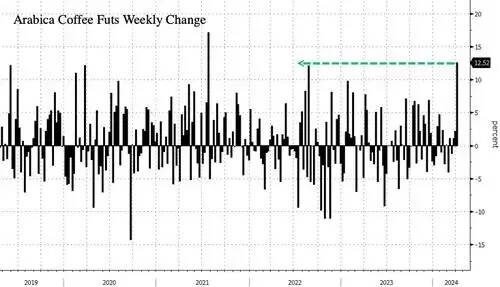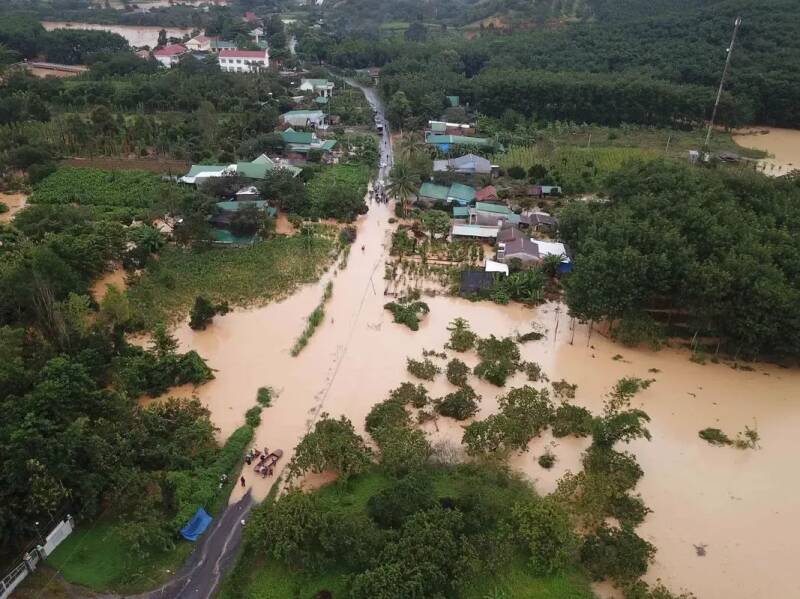Rising again! Robusta coffee futures prices are close to the $4000 mark
Earlier, the futures prices of Arabica coffee beans and Robusta coffee beans rose. Among them, the futures price of Arabica coffee beans climbed 12.5% to the highest level since October 2022.

However, coffee prices began to fall slightly a few days ago, but have risen again in recent days, with Arabica coffee prices reaching their highest level in 18 months, reaching 226.85 cents per pound. The price of Robusta coffee also reached a new high, with the pre-sale price rising as high as $3975 / ton in July 2024, close to the $4000 mark, and then falling to the final closing price of $3949 / ton, up 2.52%.
Such a rise in prices is affected by logistics. In addition, Brazil and Vietnam, the largest coffee producers, are affected by the drought, resulting in a tight supply of coffee and a shortage of stocks. According to data released by the Vietnam Coffee and Cocoa Association, Vietnam is still affected by drought and high temperatures, with local temperatures 1-3 degrees Celsius higher than last year, and the coffee industry is facing problems such as a shortage of water resources and reduced land resources. as a result, coffee production is expected to be 20% lower than the previous year's 1.84 million tons, while exports will be 20% lower than the 1.67 million tons in the same period last year.
In addition, there is a 60% chance that La Nina will occur in August in the second half of the year between El Nino, according to data such as the U.S. Government Climate Prediction Center. In general, La Nina phenomenon will strengthen convective activities in Southeast Asia, storms and rainfall processes will increase unusually, which can easily lead to floods and other disasters.

In addition, Brazil is also affected by the weather. The cumulative rainfall in the Robusta coffee region of Brazil in 2023 is at its lowest level in a decade. Although the first rainfall has recovered in 2024, it is not enough to make up for the impact of the drought in 2023. The coming La Nina weather is likely to reduce rainfall and cool weather in southeastern Brazil and increase rainfall and humidity in the northeast. The cold weather will cause a sharp drop in temperature in coffee-producing areas, which will bring frost disasters and damage coffee production in the current season and future seasons.
The harvest time of Vietnamese coffee is about between October and January of the following year, if La Nina phenomenon appears, it will seriously affect the output of Vietnamese coffee in the new production season. As a result, recently, local coffee traders are stepping up their efforts to buy coffee beans to ensure their inventory, while local purchase prices have soared to 110 million dong to 113 million dong / tonne. At the same time, Brazilian traders are also stepping up efforts to buy Robusta, so the spot price of Robusta coffee in Brazil rose to 1025 reais per bag (60 kg), breaking the 1,000 yuan mark for the first time.
And there is another potential crisis, the conflict between Israel and Iran. On the night of April 13, 2024, Iran fired dozens of missiles and drones at Israeli targets. Later, the Israeli president said that Israel did not seek "war with Iran", but that the attack "must be responded to."
However, Iran is one of the major oil producers in the world, while the Middle East is the world's most important source of oil supply. If Iran and Israel continue to conflict, the market fears that future oil sanctions against Iran may be stricter, leading to a reduction in oil supply, leading to a surge in oil prices, which will have a negative impact on the global transport industry. As a result, the trade in coffee, which relies on rail and shipping, will further push up transport costs, and so will the price of coffee.
Important Notice :
前街咖啡 FrontStreet Coffee has moved to new addredd:
FrontStreet Coffee Address: 315,Donghua East Road,GuangZhou
Tel:020 38364473
- Prev

Colombia| Introduction to the coffee producing area selection series of coffee beans
Colombia In South America, there is a country rich in natural resources and has the world-famous "four treasures": coffee, flowers, gold and emeralds. This country is known as the "Golden Country" and the world's third largest coffee producing country, Colombia (República de Colo
- Next

Blending coffee beans has become the latest trend in the world's brewing competition
▲ Click attention| Daily Boutique Coffee Culture Magazine Coffee Workshop In recent days, the high-profile 2024 World Coffee Brewers Cup (WBrC) and World Cup Test Competition (WCTC) have been staged in Chicago, USA, although there are a total of 13 countries in China.
Related
- Why does hot American coffee taste bitter? Difference in proportional concentration between hot American and ice American
- Is espresso stored overnight in the refrigerator harmful to your body? Is frozen coffee better than freshly ground coffee?
- What parameters and proportions of water temperature should be used to grind and brew fresh coffee beans? Why can't I drink freshly roasted coffee right away?
- Customers have "changed" Manner's new products! Shop assistant: Please don't mess around!
- Remove sockets in customer areas at Starbucks stores?! Netizen: I won't go if I really tear it down
- What is the difference between the taste steps of sun-dried coffee and washed coffee? Why is sun-cured coffee sweeter and washed coffee sour?
- The recipe for salty grapefruit dirty is revealed! Coffee Festival salty grapefruit dirty coffee making materials parameters ratio milk share!
- How about the flavor of Sunlight 74158 at Sidamo Banshaha Mathieu Processing Factory in Ethiopia? 74158 Share the proportion of coffee brewing parameters!
- What effect does Italian American coffee with filter paper have? Will coffee taste better if it is put on filter paper at the bottom of the powder bowl?
- What is the color difference in coffee beans? What are the characteristics of honey processed coffee beans? Why are the anaerobically treated coffee beans uneven in color?

